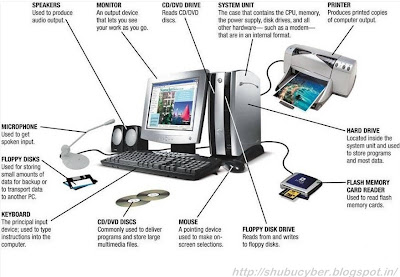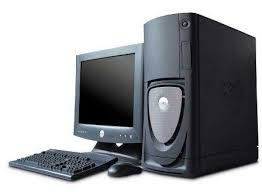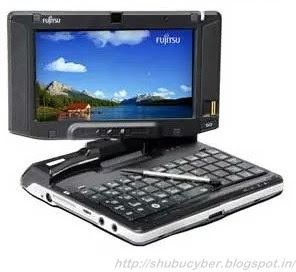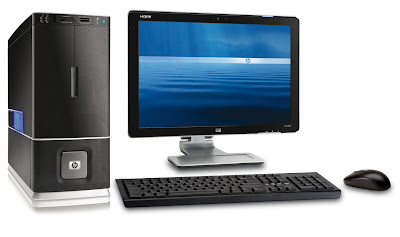What Is Computer ?
Computer is an electronic device that is designed to work with Information.The term computer is derived from the Latin term ‘computare’, this means to calculate. Computer can not do anything without a Program. It represents the decimal numbers through a string of binary digits. The Word 'Computer'usually refers to the Center Processor Unit plus Internal memory.
Computer is an advanced electronic device that takes raw data as input from the user and processes these data under the control of set of instructions (called program) and gives the result (output) and saves output for the future use. It can process both numerical and non-numerical (arithmetic and logical) calculations. The basic components of a modern digital computer are: Input Device, Output Device, Central Processor. A Typical modern computer uses LSI Chips.
Charles Babbage is called the "Grand Father" of the computer. The First mechanical computer designed by charles Babbage was called Analytical Engine. It uses read-only memory in the form of punch cards.
1) Analog Computer :-
An analog computer is a form of computer that uses the continuously-changeable aspects of physical phenomena such as electrical, mechanical, or hydraulic quantities to model the problem being solved. In contrast, digital computers represent varying quantities incrementally, as their numerical values change.
Mechanical analog computers were very important in gun fire control in World War II and the Korean War; they were made in significant numbers. In particular, development of transistors made electronic analog computers practical, and before digital computers had developed sufficiently, they were commonly used in science and industry.
2) Digital Computers :-
A digital computer is designed to process data in numerical form its circuits perform directly the mathematical operations of addition, subtraction, multiplication, and division. The numbers operated on by a digital computer are expressed in the binary system; binary digits, or bits, are 0 and 1, so that 0, 1, 10, 11, 100, 101, etc., correspond to 0, 1, 2, 3, 4, 5, etc. Binary digits are easily expressed in the computer circuitry by the presence (1) or absence (0) of a current or voltage. A series of eight consecutive bits is called a "byte"; the eight-bit byte permits 256 different "on-off" combinations. Each byte can thus represent one of up to 256 alphanumeric characters, and such an arrangement is called a "single-byte character set" (SBCS); the de facto standard for this representation is the extended ASCII character set. Some languages, such as Japanese, Chinese, and Korean, require more than 256 unique symbols. The use of two bytes, or 16 bits, for each symbol, however, permits the representation of up to 65,536 characters or ideographs. Such an arrangement is called a "double-byte character set" (DBCS); Unicode is the international standard for such a character set. One or more bytes, depending on the computer's architecture, is sometimes called a digital word; it may specify not only the magnitude of the number in question, but also its sign (positive or negative), and may also contain redundant bits that allow automatic detection, and in some cases correction, of certain errors. A digital computer can store the results of its calculations for later use, can compare results with other data, and on the basis of such comparisons can change the series of operations it performs. Digital computers are used for reservations systems, scientific investigation, data-processing and word-processing applications, desktop publishing, electronic games, and many other purposes.
There are three types of computer :-
i) Super Computer :-
Extremely fast data processing-oriented computer whose number crunching power is (presently) measured in hundreds of billions of floating point operations (gigaflops). Supercomputers really on parallel-processing technology and can use only a few but very complex programs in modeling economy behavior, nuclear reactions, meteorological and neurological phenomenon, etc. First supercomputer (Cray-1) was made in 1976 by the US engineer Roger Cray (1925-1996). Or in simple word you can say that...
A large computer or collection of computers that act as one large computer capable of processing enormous amounts of data. Supercomputers are used for very complex jobs such as nuclear research or collecting and calculating weather patterns. Below is an example picture of a super computer at the William R.Wiley Environmental Molecular Sciences Laboratory, the Linux-based supercomputer is composed of nearly 2,000 processors.
ii) Mainframe computer :-
A Mainframe computer is a very large and expensive computer capable of supporting hundreds, or even thousands, of users simultaneously. IBM builds Mainframe Computers. Today, a Mainframe refers to IBM's zSeries computers. Big companies; Banks, Insurance Companies, Travel and Retail Sector, Telecom Companies employ Mainframes for processing their business data. Today, thousands of people around the globe book flights, do Electronic Money Transfers, swipe their credit-cards for purchases. These transactions are processed in a snap by a Mainframe computer.
iii) Mini Computer :-
A minicomputer is a type of computer that possesses most of the features and capabilities of a large computer but is smaller in physical size. The name can be a bit misleading. In fact, minicomputers are several times the size of desktop PCs and are only one step below mainframes in the hierarchy of computer classes.
The term "minicomputer" was introduced in the 1960s to describe powerful computers that were not as large as mainframes, which sometimes could fill an entire room. Instead, most minicomputers were a few feet wide and several feet tall. They were primarily used by large businesses during the 1960s and 1970s to process large amounts of data. Some minicomputers also functioned as servers, allowing multiple users to access them from connected terminals.
As computer processors became smaller and more powerful, microcomputers began to rival minicomputers in processing power. Therefore, in the 1980s, minicomputers started becoming less relevant and eventually became obsolete. Today, rack-based servers perform similar functions to minicomputers.
iv) Micro Computer :-
You can say that the term microcomputer is generally synonymous with personal computer (PC), or a computer that depends on a microprocessor. Microcomputers are designed to be used by individuals, whether in the form of PCs, workstations or notebook computers. A microcomputer contains a central processing unit (CPU) on a microchip (the microprocessor), a memory system (typically read-only memory and random access memory), a bus system and I/O ports, typically housed in a motherboard.
Microcomputers became popular in the 1970s and 80s with the advent of increasingly powerful microprocessors.
3) Hybrid Computer :-
Hybrid computer is a digital computer that accepts analog signals, converts them to digital and processes them in digital form. This integration is obtained by digital to analog and analog to digital converter. A hybrid computer may use or produce analog data or digital data. It accepts a continuously varying input, which is then converted into a set of discrete values for digital processing. A hybrid computer system setup offers a cost-effective method of performing complex simulations. A hybrid computer capable of real-time solution has been less expensive than any equivalent digital computer. Hybrid computers have been necessary for successful system development. An example of a hybrid computer is the computer used in hospitals to measure the heartbeat of the patient. Hybrid Machines are generally used in scientific applications or in controlling industrial processes.
hope u like this post extemely its very common things but to know every is more important so...
















0 comments :
Post a Comment